
Running a successful restaurant takes a lot of time, effort, and preparation; there are multiple things to know before starting your own restaurant. Due to the difficulties that comes with this endeavor, it pays to have your own business checklist to help keep you on the right track. In creating one, know that things will not stay the same for long. As you progress, you’re going to have to shake things up since your restaurant’s needs will continue to evolve. With that said, let’s move on to what you can prepare for before the opening of your restaurant.
6 Months Before Opening
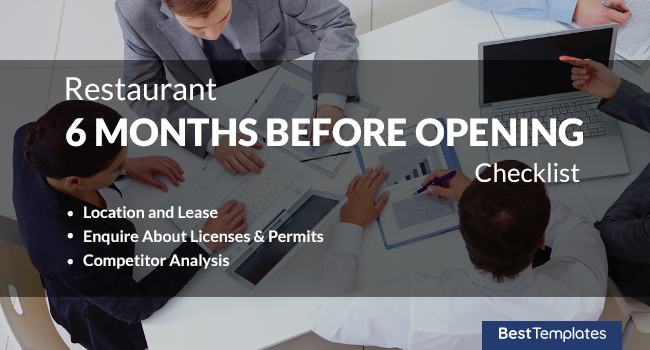
Preparation is the key to successfully taking advantage of business opportunities. At this point, you would still have to deal with selecting a location, getting permits, and analyzing the competition. In each specific part of the checklist, there are multiple decisions and alternatives at your disposal, so take the time to consider each one thoroughly.
-
Location and Lease
Choosing a location that’s best for your restaurant comes with heavy research and considerations. It is best to find a place as early as six months because of the important role location plays in the marketing and strategic aspects of the business. For locations, you can either choose to lease or purchase a space. A lease proposal would be needed for the former, whilst crafting an excellent proposal to buy would be appropriate for the latter.
-
Enquire About Licenses & Permits
Half a year before the opening of your restaurant is enough time to gather a list of licenses & permits you may need for a restaurant. What you’ll need is bound to differ from others, depending on what type of establishment you’ve got planned.
-
Competitor Analysis
Even at this stage, you should be eyeing the potential competition and figuring out what they have to offer the public. A way to make things easier would be to have a competitor analysis worksheet. You may also want to look into competitor analysis worksheets and market analysis templates. Those two are sure to be of great help as you study the market and those within. Using the worksheet, take note of their strengths, weaknesses, specific services, and how well customers respond to them. Doing so at this stage can provide you with enough time to prepare counter measures.
3 Months
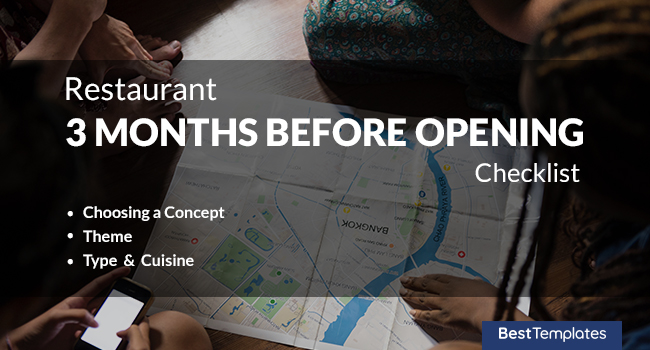
By three months, your location, permits, and thorough analysis of your competition should already be taken care of. From here on out, you must work out the details of the business. This involves ironing out the details of the concept, what type of cuisine you’re serving, the plans for the budget, and the interior design. To be specific, here’s what you can do for each area of the business at this point.
-
Choosing a Concept, Theme, Type, & Cuisine
The decisions you make here affect how your design for the restaurant cuisine goes, your service, and what people will know you for. Once you’ve select the type of restaurant or theme, you can move on to other aspects of your restaurant.
-
Budget Plan
Prepare your plans for your budget according to what you plan to get. A smaller restaurant will need less capital to operate on and the price of ingredients will differ between fancy and casual restaurants. Ensure that whatever you get fits within your budget plans so that you can avoid the ever-present danger of overspending.
-
Business Plan
Three months before the planned launch of your restaurant is reasonable enough time to sort out your restaurant business plan. Here you write the background information of what is needed to succeed in your endeavor. Within the allotted period, list all your goals, how you intend to achieve them, why they are reasonably attainable, and more.
-
Investment
The importance of funding at this stage of your business should not be understated. Investments can help shape and achieve the goals you’ve outlined on your business plan for investors, so seeking out funding is crucial to your future success.
-
Interior Design
Presentation plays a big role in making an impact to your audience. Long before the opening of your restaurant, the interior design of the physical location should be taken care of. Keep your theme and concepts in mind as you go about turning your goals into achievements.
75 Days to Before Opening the Restaurant

Imagine how close opening day is and you’ll grasp just how important it is to realize staff plans, gather equipment, and work on your branding. As you continue to work on the aforementioned business plans, and interior design, be sure to take good care of the more specialized areas of the business.
-
Staffing
For staff planning, you need to ensure that your organization has the right people for each of the roles that need filling. Start by specifying what their job descriptions entail and what skills are required of them. You must also include fair employment considerations.
-
Equipment
Take a look at your business plan and see what you need and what you don’t. Cover only what is necessary and be careful of the quality of what you get. Note that you don’t have to get everything new; second-hand equipment can work just as well and tend to be a lot cheaper. As an alternative to buying, you can also lease equipment. This is particularly helpful for those machines with shorter life spans. Working with the interior design in mind, look at how the aesthetic of your tables and chairs match up with your restaurant’s theme.
-
Branding and Identity
Having handled your business plans, investments, and concepts, now would be a great time to solidify your branding. Consider your target market and what message you will send them. Take into account which distribution channels you’ll be incorporating into your brand strategy. Remember that the actions you start here need to be consistently and strategically implemented as you go along with your business.
60 Days Out

With just two months left to go, now would be the time to focus on your products and services. During this period, you’ve got two primary objectives: to design your restaurant’s menu and to come up with training plans for your employees. Here’s a look at how you can succeed at both of these goals.
-
Designing Menu
As you go about designing a menu for your restaurant, you must have an awareness of certain eye scanning patterns. Looking to divide your menu into the most logical sections will help your customers out a lot. If you’re planning to use photos, only do so sparingly. A pic here and there of your specialty dishes should already be effective. If you’ve already hired an experienced chef, then you may want to consult him/her so that you can come up with creative selections.
-
Training Plan
When creating training plans for your staff, the first thing to do would be to set clear goals. Write them down if you must to avoid forgetting them. Set these plans up specifically according to each job description. Take into consideration the pre-existing skill and talent of the employee as well; it would be a waste of both time and money for someone to be trained when they’re already proficient in what they do.
45 Days Out

Your menu may be thoroughly designed, but how much does each dish cost? At this point, the price, point of sale, and food production needs are all logical next steps to be taken care of. Here’s how you can effectively handle all three:
-
Pricing
The first thing you should look into when deciding the prices would be the cost of the ingredients. Another consideration to look into would be portion control. In learning how much each ingredient costs and how much is used, you can get a great idea of how much you should price something.
-
POS
Having a point of sale is necessary because it can help track sales, your food inventory, cash flow, and even your bookkeeping. It would be overwhelmingly difficult to keep track of everything without one due to the sheer volume of credit cards and cash coming in on a daily basis. A few examples of POS systems that are restaurant-specific are Aldelo, POSitouch, Digital Dining, and Radiant Systems.
-
Determine Food Production Needs
To help determine your food production needs, you need to get a good grasp of inventory management. Also make sure that you are aware of your equipment capabilities. Everything has to be working well and your storing methods must be consistent with the standards of the health department. Your staffing also influences your food production needs. Take note that peak hours for restaurants will be around lunch or dinner. Schedule their shifts with that knowledge in mind so that you’ll have only minimized downtime.
30 Days Out
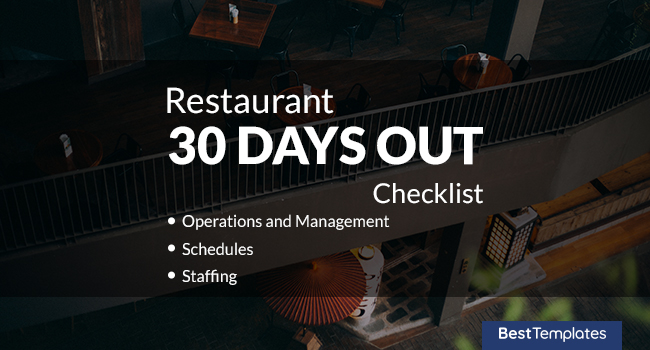
With just a month to go, you need to ramp up the operational and management aspects of your business. This means dealing with your staff, their schedules, and the advertising. You don’t have much time, so here’s how you can improve things before your opening:
-
Operations and Management
When it comes to operations and management spreadsheet, there are varied duties that you can tackle and prepare for. Guest experience, as you know, is of utmost importance. You don’t have to take the saying ‘the customer is always right’ literally. That does, however, mean that how you handle their complaints and various other scenarios will determine whether or not their experiences with you is good or bad. Keep yourself up to date as well by preparing a management report and an operations checklist. Ensure that your employees have read and understood your restaurant operations manual so that they’ll be clear with what to do and how to keep things running smoothly.
-
Schedules
This largely concerns the shifts of your employees. Restaurant production has to be seamless, and to do that, you must be a well-oiled machine when it comes to your scheduling. On a daily basis, you need to ensure that you scheduled enough employees. It would be to your best interest to keep some on the call just in case. Make sure that you’ve got more than one manager working at any time. Most important of all, you need to ensure that your employees have sufficient time to rest from each shift.
-
Staffing
When it comes to hiring employees, you can either work with a staffing agency or put out an ad for prospective employees to respond to. Either way, you need to make sure that their knowledge, skill, expertise, and experience are appropriate for the jobs that needs filling. Coming up with a staffing plan is a great way to keep your hiring process organized.
-
Sidework
What you need to prepare for sidework is detailed assignments for your servers. This should make their responsibilities perfectly clear. Besides that, it also ensures that all of their tasks are done in a timely and consistent manner. A server side work checklist isn’t actually only for the servers; they can also be helpful towards hosts, bussers, and various other positions at the front of the house.
-
Advertising & Marketing
The first thing to remember in advertising your restaurant is to know who you are marketing to. Once you’ve identified your target market, feel free to employ a different number of strategies. Social media is a common and effective method of marketing. You may also want to try doing more traditional things, such as weekly or even daily promotions. Now’s the perfect time to sort out your marketing plan and your marketing budget plan.
15 Days Out
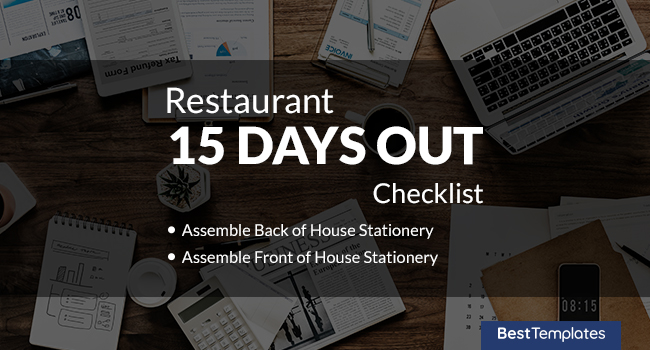
So now you have only a little over two weeks and in that time, you need to establish front of house and back of house stationery. Recognizing the difference between these two and how they function can help your efforts substantially. Between them, here are the things that you will need to prepare for the future benefit of your staff and your customers.
-
Assemble Back of House Stationery
Considering this is the ‘behind the scenes’ part of the restaurant, you’ll be busy preparing for things like your cookbook, and an order confirmation template. You can work together with your chef in order to determine what to get and how you can acquire them at this point of your restaurant’s development.
-
Assemble Front of House Stationery
Among the things you need to prepare for the front of house stationery would be the menu. You’ll also need to ensure that you’ve got business cards and the small presentation folder taken care of as well. After all, these are items that ought to be readily accessible to customers, as well as those working at the restaurant’s front.
7 Days Out

In a week’s time, you’ll be opening your restaurant to the public. Your priority in this time should be inspection and reviewing. This includes looking into all of your products, finalizing your restaurant’s menu, making sure your signage is in place, and completing all the necessary paperwork. You can’t afford to miss out on anything anymore, so be as thorough as you can.
-
Receive All Products & Inspect
As you prepare to receive and inspect your products, it would make the job a lot easier to have an inspection checklist. Another useful tool would be a multi-unit inspection checklist, which includes guidelines and scorecards. Utilize this as well whenever you need to evaluate someone’s performance or their compliance.
-
Confirming Smallwares
By now, your restaurant should receive kitchen equipment & install each one successfully. Take note of what you ordered and see which has been delivered and which ones are still on their way. Make a list if it is something that you think can help.
-
Finalize the Menu
One thing you can do to help finalize your menu is to make use of a menu item quality review template. This useful tool is customizable and can help you evaluate based on several factors. Included in the evaluation are the presentation, portions, taste, temperature, doneness, value perception, side dishes, packaging, the timing, and many other service considerations.
-
Signage & Bulletin Boards
If you want to add a little style to your restaurant, digital signage is the way to go. This is among the rising trends in the industry for several reasons. One is that it helps in improving customer communications. Another is that they tend to create a much livelier atmosphere for your restaurant. You can even make money off it, since advertising partners can display their ads on your digital signs. If this is something that you’re interested in, then finalizing your sign templates a week before opening should be the last and best time to do so.
-
Complete Paperwork
This is pretty self-explanatory. Any paperwork, intended for any reason, that you need to complete and process should be accomplished around this period. There could be deadlines to catch up to, or perhaps things will just be that much hectic once the restaurant opens. Do not put off what needs to be done now.
1 Day
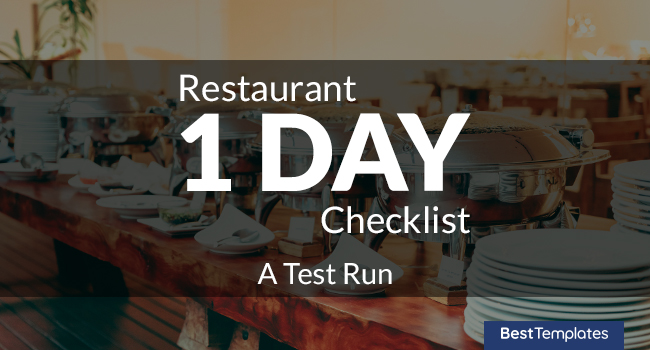
A day before your opening can be dedicated to a little bit of rest and relaxation. There’s not a lot more you can accomplish at this point, but you can still make progress in smaller ways.
-
A Test Run
A fine way to see how well things can go during the grand opening is to have a test run. Serve free meals to friends & family get their honest feedback on the dishes and the quality of service. Although this benefits your work, it can be fun to serve to your friends and family. Think of it as the calm before the storm.
Post Opening Checklist
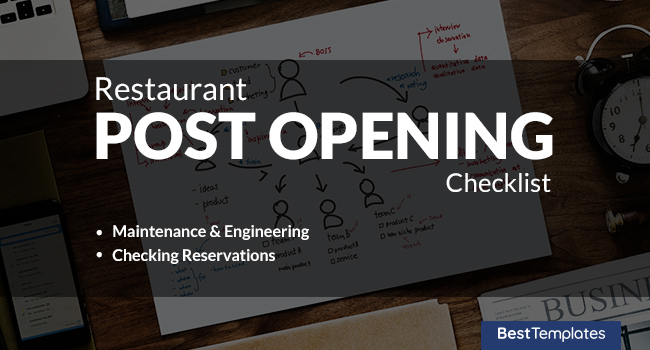
-
Starting Procedures for Staff
When it comes to starting procedures, you must first establish a code of conduct. After all, this is where employees would look towards when it comes to their questions of compliance and ethics. Included in this are procedures about attendance, dress code, and workplace safety rules. Another procedure to be established for your staff ought to be your communications policy.
-
Maintenance & Engineering
The key to proper maintenance is to have your own maintenance schedule. Creating a maintenance checklist also helps you in keeping track of what needs to be done. Now that your restaurant is open and operations and underway, the point now is to ensure everything is kept in consistently excellent condition.
-
Checking Reservations
Depending on the type of restaurant you’re handling, you may have to ensure that your guests can avail of reservations. To do this, you need to have your own reservation form. Another thing that can help with your day-to-day operations is a table reservation checklist. As your restaurant grows, more people will want to reserve their own tables, so the latter becomes practically an essential checklist to have.
Closing Checklist
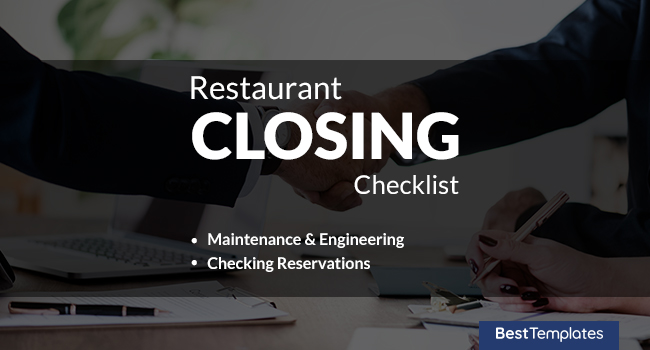
-
Maintenance
Setting up a daily cleaning schedule for your staff to follow is essential for proper restaurant maintenance. Your staff should be directed on when they are to clean and who is scheduled to do it. Beyond that, they also need instructions regarding their equipment cleaning schedule. Having a clean and proper restaurant will have a positive impact on your customers, not to mention well-maintained equipment will lead to smooth and steady operations.
-
Accounting & Finance
You need to have proven accounting processes if you are to create your own profitable business. Among the things you can’t afford to neglect would be your payroll hours confirmation log and daily cash audit form. Although you can handle this aspect of your business by yourself, there might be times when it would be more prudent to leave it to other professionals. Hiring the financial services of an accountant might be costlier, but you’ll see just how worth it the decision can be.
If you are to survive and thrive, you need to accumulate as much knowledge as possible. Learn all about the challenges building a restaurant & how to overcome them. As shown in this article, there are a lot to think about and accomplish. But as long as you consider what you have to do and give yourself enough time, all these tasks are quite doable.
